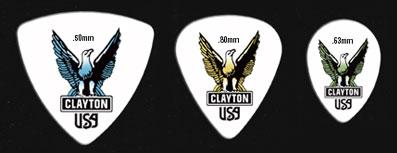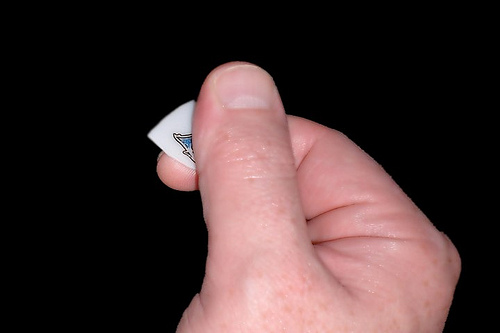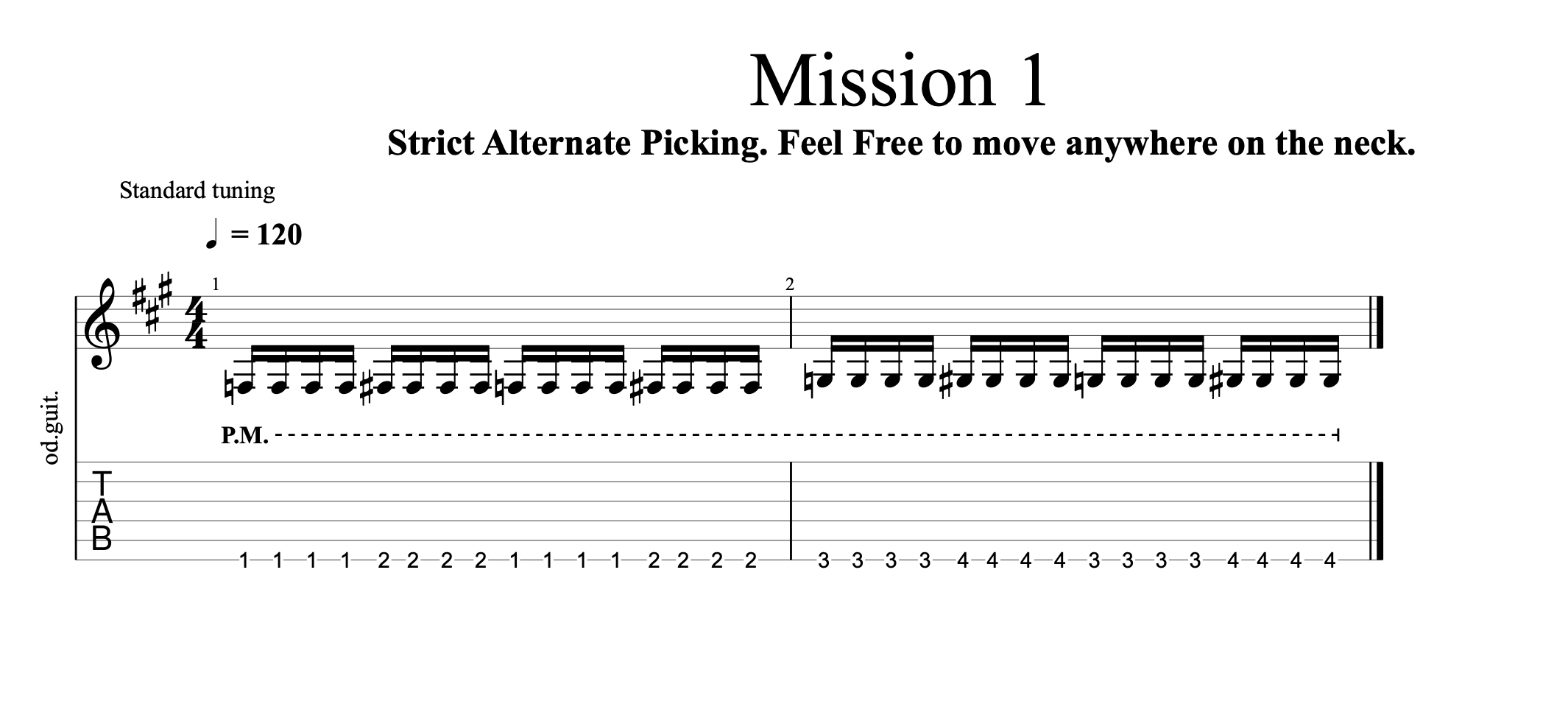Lesson Series: “0 To 60, An Introduction to Alternate Picking” - Lesson 1
Contents |
LESSON #1 - Getting Started With Alternate Picking
Lesson Series by Todd Simpson
What is "Alternate Picking"? I'm sure you have heard the term thrown about as meaning a variety of things. For our purposes, alternate picking is simply alternating between up and down strokes. You may have also heard of "Economic Picking", this is something else. Economic picking has more to do with combining up and/or downstrokes in groups of more than one in order to maximize efficiency of picking in the context of playing a given pattern.
Quick Vocabulary: "Alternate Picking" (Per: Wikipedia.org) :
Alternate picking is a guitar playing technique, used only by pick users, that employs strictly alternating downward and upward picking strokes in a continuous run, and is the most common method of plectrum playing. If this technique is performed on a single note at a high speed, then it may also be referred to as tremolo picking. 'Good' alternate picking involves a continuous down-up or up-down motion of the picking hand, even when not picking a note (except when the gap lasts longer than one full up-down motion). In this manner, an up-beat (such as an even-numbered eighth note or, at faster tempos, sixteenth note) will always be played with an upward picking stroke, while the down-beats are always played with downward picking strokes. This allows for fluid incorporation of legato-based notes such as hammer-ons and/or pull-offs in the middle of picked phrases. The technique has many advantages and some disadvantages, largely depending on the licks the guitarist is attempting to play. For example, most scalar runs are most easily played using alternate picking. Similarly, the complex, syncopated rhythm guitar patterns found in death metal require a good alternate picking technique to play fast and accurately. On the other hand, large arpeggios (especially those spanning more than one octave) are very difficult to play using pure alternate picking and almost impossible to play at great speeds, which is why many guitarists choose to employ sweep picking to play these arpeggios (eg. K.K. Downing, Frank Gambale & Mario Parga). Similarly, some kinds of licks are easier when played using such specialised techniques as legato, economy picking (a hybrid of alternate and sweep picking) or tapping. Despite some of the well-known disadvantages of the technique, some guitarists (especially Al Di Meola and Steve Morse) emphasize the near-exclusive use of alternate picking, even in situations where another technique would be easier, claiming that pure alternate picking leads to a more consistent sound and allows for greater control of tone. Alternate picking can be heard in almost all styles of picked guitar music, from Jazz, Bluegrass, to Heavy Metal. It is also very often used in a subgenre of heavy metal, thrash metal. Victor Wooten uses his thumb for alternate picking, as displayed on his DVD "Super Bass Solo Technique".
Dick Dale is famous for his fast alternate picking technique.
There are several styles of music that make use of this style of picking. The first styles that may come to mind are probably the heavier styles such as all of the various flavors of Metal (Death/Progressive Metal in particular), Jazz (The more free form varieties), even Bluegrass. In order to play a sequence of notes with any significant speed, alternate pickings is essential. Simply repeating up or down strokes will eventually just not do the trick. Alternate picking is often used when playing leads or "solos", but it is also handy when playing complicated rhythm parts as well. We will start working on alternate picking at very slow speed and on only one string. Once we have that down, we will increase speed and move on to multiple strings. Changing strings while alternate picking is one of the most important things you will need to learn and master in order to be truly expressive with your instrument.
Introduction to the Pick / Pick Choice
Before we get too far in to alternate picking, lets talk about the pick. The fist thing you will need to do is select a "Pick" or "Plectrum" as the European's sometimes call it. The choice of pick is a critical first step. You may have tried several picks and settled on a particular shape, style, make etc. If not, I would honestly recommend that you select a thick pick. I use Clayton brand picks in 1.0 mm thickness, and molded in a "Standard" shape.
Picture: a selection of Clayton picks. The "Standard" shape is the one in the middle. Rounded Triangle is on the left and Small Teardrop is on the right. These picks are available in thicknesses of .38mm, .50mm, .63mm, .80mm, 1.00mm, 1.26mm, 1.52mm, and 1.90mm
I find that these are thick enough so that they don't have too much "Flex" (The amount of bend a pick has) and they are not so stiff that I rip through strings constantly. Also, they have a non-glossy finish that prevents them from slipping out of your hand or automatically changing orientation in response to the strings. Being able to control your pick is the first critical step.
Once you have selected a pick, get a bit of sand paper (Here is where the secret sauce begins) and rub the sides of the pick to a fine V shape. Do not construct a "Weapon Pick" as it does not need to cut glass. The idea is to simply reduce the surface area of the exact point at the end of the pick where it will strike the string. Having too much of the pick strike the string can slow down your technique. Ideally, you will eventually only want the very tip of the pick to cross the string and cover a very small distance so that it has less distance to travel on it's way back to complete the stroke. Such things may seem extreme at first, but as you begin to play faster and faster, subtle things like pick point surface area become more and more important.
Angles of Attack
Once you have decided on a pick, it’s time to attack the strings. First, grip your pick between the thumb and first finger with the tip of the pick pointing away from your thumb at a 90 degree angle.
Once you are comfortable holding the pick, it’s time to find your “Angle of Attack” on the strings. Let’s focus on one string. Pick any string on the guitar. Place the pick next to the string at a near right angle. Try to pick the string with as little movement as possible. Smaller movements are key in gaining speed. Larger, more exaggerated picking movements are not best suited for alternate picking. Focus on a very small up and down stroke while trying to minimize motion of the wrist and forearm. Ideally, your pick hand should barely move when alternate picking. Watch the video for this section and replicate what you see to the best of your ability.
The choice of whether to start your alternate picking from an upstroke (bringing the pick up toward you), or downstroke (pushing the pick away from you) is a critical decision that is worth considering. The important thing to remember is, are you going to higher/thinner strings, or are you going to lower/thicker strings. If you are moving to higher strings, you can start with a down stroke, then change positions slightly and be prepared to follow with an upstroke. Or, you can lead with a down stroke and using “Economic Picking” repeat the downstroke on the next string you are moving. However, this is not considered “Alternate Picking” as you are no longer alternating up and down strokes but are combining two up or down strokes back to back. This something that will will use to make our alternate picking more efficient once we start changing strings.
When deciding on initiating with an up or down stroke, take the rest of your intended strokes in to account and plan accordingly. You can start with either up or down stroke depending on what feels best to youl. There is no one “right” way, as such. Instead, trust your instincts as a player. If you don’t feel you have any “instincts”, this is the time to work on developing some.
Consider a scale that you are about to play. Think of whether your flow through the scale would best be served by initiating with an up or down stroke. If you plan on alternate picking, you will need to find out if you are more comfortable starting with downstrokes, or upstrokes. In the end, this boils down to personal preference. I personally, like to start most patterns on a down stroke. I have initiated on a downstroke twice as often as I would have if I would have decided to alternate between initiating on up then down. So I have effectively double the amount of practice hours that I have put in to working with the down stroke initiation approach. However, some players choose to focus on the upstroke initiation such as Marty Friedman. This is arguably equally effective. A third approach may be more balanced in which the initiation is split between up and down strokes. Realize that this approach may take more time to perfect as you are going to need to practice patterns and scales using both up and down stroke initiation.
Working With a Metronome
Now that you have chosen your pick, and seen some examples, let's talk briefly about working with a metronome. Being able to work with a metronome is key to your success. As mentioned before, a software or hardware metronome will do. Really any type of metronome you can get your hands on even if it's a freebie download that is only good for 30 days. Just something to get started. When playing with a metronome, start low and work the BPM (Beats Per Minute) up until you find the spot where you need to improve. At a certain speed, you will feel like your losing control and your right and left hands are doing different things. This is the "Sweet Spot" that you will need to work up from in order to improve.
Select a string, say the "A" string and begin to pick up and down in an alternating pattern. See how fast you can go before it gets uncontrollable and uncomfortable and reduce the BPM. Then get used to the feeling of alternate picking by playing for several minutes at a stretch along with the metronome. Don't worry about your left hand yet. Just practice on the right hand for now. Over the next 30 minutes, see if you can slowly creep up the BPM on the metronome each time you do a new set. Find the spot where it is playable but difficult. Play at this spot for several minutes at a stectch. Do not play EVER until you feel pain. This is not a Gym. "No Pain No Gain" is not the motto.
Practice Time
PRACTICE TIME ( At Least - 30 Minutes)
Now that you have the pattern down, spend the rest of your practice time on the following and repeat for every practice session you have during the week.
Start at the first fret on the low E string. Start your metronome. Begin to alternate pick. Every four counts, move your left hand up one fret. Go up to the 12th fret then repeat on all the other strings. Do several sets of playing through this pattern. After a while try to turn the metronome up again and see if you are able to play a bit faster. This is the real secret to getting faster. Slowly pushing your comfortable playing speed up and up and up over time. It takes work, but it is possible to play as fast as you like with enough practice.
Repeat this workout several times this week during your practice time. Remember, if it feels too loose or sloppy or out of control, you are trying to go to fast! Slow the metronome down just a bit and find the "zone" and work up from there.
Here is a short video to let you hear how it will sound and what it will look like when played at speed:
Repeat this workout several times this week during your practice time. Remember, if it feels too loose or sloppy or out of control, you are trying to go to fast! Slow the metronome down just a bit and find the "zone" and work up from there.
Lesson Series by Todd Simpson 140semi









